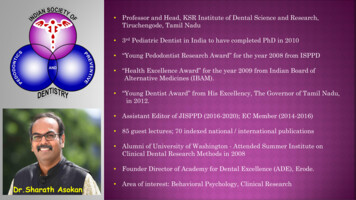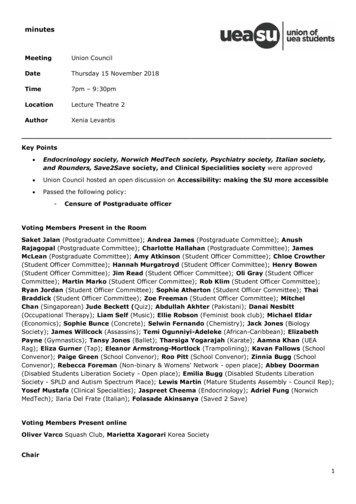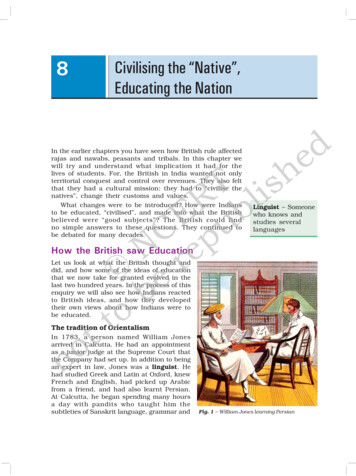
Transcription
Professor and Head, KSR Institute of Dental Science and Research,Tiruchengode, Tamil Nadu 3rd Pediatric Dentist in India to have completed PhD in 2010 “Young Pedodontist Research Award” for the year 2008 from ISPPD “Health Excellence Award” for the year 2009 from Indian Board ofAlternative Medicines (IBAM). “Young Dentist Award” from His Excellency, The Governor of Tamil Nadu,in 2012. Assistant Editor of JISPPD (2016-2020); EC Member (2014-2016) 85 guest lectures; 70 indexed national / international publications Alumni of University of Washington - Attended Summer Institute onClinical Dental Research Methods in 2008 Founder Director of Academy for Dental Excellence (ADE), Erode.Dr.Sharath Asokan Area of interest: Behavioral Psychology, Clinical Research
Non-PharmacologicalBehavior Management(or)Behavior Guidance
Equilateral triangle Dynamic relationship Focus on child - Apex 1:2 relationshipGerald Z. Wright, Ari Kupietzky. Behavior Management in Dentistry for Children.2nd Edition.
Stone and Church Classification (1975) Infant (0 to 15 months) Toddler (15 months to 2 years) Preschooler (2 to 6 years) Middle Years Child (6 to 11 years) Adolescent ( 11 years)R.J. Mathewson, Robert E. Primosch. Fundamentals of Pediatric Dentistry.
Preschoolchildren( 3 years)Fear of falling, noiseFear of sudden movementsFear of strangersFear of separation from parents4 yearsFear of bodily injury5-6 yearsEmotional instabilityCombat with fantasy, imaginary playProud of possessions7 yearsAlternatively brave and cowardResolving fearLogical reasoning8-14 yearsLearned to tolerateObedientSidney B. Finn. Clinical Pedodontics.
Behavior PredictionAsokan S, Surendran S, Punugoti D, Nuvvula S, Geetha Priya PR. Validation of a novel behaviorprediction scale: A two-center trial. Contemp Clin Dent 2014;5:514-7
Frankl Behavior Rating Scale (1962) Type 1 - Definitely negative (refuses treatment, cries forcefully,extreme negative behavior) Type 2 - Negative (reluctant to accept treatment, displays slightnegativism) Type 3 - Positive (accepts treatment) Type 4 - Definitely positive (unique behavior; establishes rapport) Wright’s modification in 1975 Symbols (- and ) Right sided arrow mark
Wright’s classification of cooperative behavior (1975) Cooperative behavior Lacking cooperative behavior Potentially cooperative behavior Uncontrolled Defiant Timid Tense cooperative Whining Passive Resistance (2014)Gerald Z. Wright, Ari Kupietzky. Behavior Management in Dentistry for Children.2nd Edition.
Fear, Anxiety, PhobiaAnxiety - unknown dangerFear - known danger or threatPhobia - persistent, excessive, unreasonable fear toobject, activity or situationFearObjectiveSubjectiveSuggestiveSidney B. Finn. Clinical Pedodontics.Imitative
Reasons for Dental Fear Fear of Unknown Fear of Pain Lack of Trust Loss of Control Fear of IntrusionChapman, Kirby-Turner. Dental fear in children - a proposed model.Br Dent J 1999; 187(8):408-12.
Children's Dental Fear Picture test- Dental Setting Pictures (CDFP-DS),- Pointing Pictures (CDFP-PP),- Sentence Completion test (CDFP-SC).
“Self-report is the first method of choice when studying pain and/or anxiety.However, children under eight years of age have limited cognitive capacities:to depend on the accuracy of their reporting (ten Berge 2001) offers a greaterrisk of incorrect information. To improve the information on self-reportingrating scales for young children, some investigators have used small icons ofdentistry-related situations or happy-to-sad faces as clinical endpoints(Venham et al. 1979; Wong and Baker, 1988, Chapman and Kirby-Turner, 2002).In general, visual analogue scales (VAS) are the most effective with young children,with “very cooperative” and “uncooperative” as the clinical endpoints.”“1990s the Children’s Fear Survey Scale-Dental Subscale (CFSS-DS) has receivedconsiderable attention. Initially presented by Cuthbert and Melamed (1982), theCFSS-DS has been used worldwide.”- Veerkamp SJ
Klinberg et al. Child dental fear: cause-related factors and clinical effects.European Journal of Oral Sciences 1995; 103(6):405-412.
Cry (Elsbach,1963) Obstinate Cry Frightened Cry Hurt Cry Compensatory Cry
Parental Role@ One tailed (Bell)@ Immediate social environment@ Parental presence / absence(based on age)@ Factors of fear - Suggestive
Baumrind Parenting Styles (1973)Maccoby & Martin (1983)Viswanath S, Asokan S, Geethapriya PR, Eswara K (2020) Parenting Styles and their Influence on Child'sDental Behavior and Caries Status: An Analytical Cross-Sectional Study. Journal of Clinical PediatricDentistry 2020; 44(1): 8-14.
Behavior managementmeans by which the dental health team effectively andefficiently performs dental treatment and thereby instills apositive dental attitude.Behavior Guidanceis a continuum of individualized interaction involving thedentist and patient directed toward communication andeducation “which ultimately builds trust and allays fearand anxiety”.
Behavior modificationan attempt to alter the human behavior and emotion in abeneficial way and in accordance with the laws of learning.Behavior shapingprocedure which develops behavior by reinforcingsuccessive approximations of the desired behavior until thedesired behavior comes into being.
Fundamentals of behavior lerantOrganisedTruthful
Domains in Behavior Management Linguistic Domain Reward-oriented Domain Aversive Domain Physical Domain Pharmacologic DomainJimmy Pinkham, Paul Casamassimo, Henry Fields, Dennis McTigue, Arthur Nowak.Pediatric Dentistry - Infancy Through Adolescence. 4th Edition
Basic BG Communication Positive pre-visit imagery TSDAdvanced BG Protective stabilization Positive reinforcement Distraction Parental presence / absence Sedation General anesthesia Memory restructuring Voice control Nitrous oxide inhalationAAPD. The reference manual of Pediatric Dentistry. 2015.
CommunicationMehrabian(2009)Sharath Asokan, Sivakumar Nuvvula. Pediatric Dentistese. JISPPD 2017; 35(1):2-5.
Multisensory communication Message clarity Euphemism “Second language” Problem ownership Active listening Appropriate responses Scheduling appointment (time)
Tell-Show-Do (Addleston,1959) Cornerstone of behaviour management Based on desensitisation Step by step successive approximations Effective above 3 years of age First visit, introduction of new procedure Fearful, apprehensive childrenSharath Asokan et al. Children's Behavior Pattern and Behavior Management TechniquesUsed in a Structured Postgraduate Dental Program. JISPPD 2009;27(1):22-6.
Ask Tell AskTeach Back Inquire about visit / procedure Low literacy patients Explain in non-threatening language Demonstrations can be checked Ask how child feels about it Normal routine Avoid ‘doctor babble’ - TTTMotivational Interviewing Uses person’s own reason for changeTell Play DoTender Loving Care (TLC) Increases confidence Brushing, flossing, reducing sugars Open-ended questions (O) Affirmations (A) Reflective listening (R) Summarizing (S)AAPD. The reference manual of Pediatric Dentistry. 2015.
Contingency Management Presentation or withdrawal of reinforcers Reinforcers - positive and negative 3 types of reinforcements- Social (praise, hand shake, pat, hug)- Material (gifts, toys not sweets)- Activity (watching TV show, cartoon)James Coxon et al. What reward does a child prefer for behaving well at the dentist?BDJ Open 2017.
Contingency ManagementProbability of responseincreasesProbability ofresponse decreasesPleasantStimulus(S1)S1 PresentedPositive Reinforcement“Reward”S1 WithdrawnOmission /Time outUnpleasantStimulus(S2)S2 WithdrawnNegative Reinforcement“Escape”S2 PresentedPunishment
DistractionDistraction is the technique of diverting the child patient’sattention from what may be perceived as an unpleasant procedure.Objectives- decrease the perception of unpleasantness,- avert negative or avoidance behavior.IndicationsMay be used with any patient.ContraindicationsNone!AAPD. The reference manual of Pediatric Dentistry. 2012.
Active Distraction Interactive toys Controlled breathing and relaxation Guided imagery Virtual realityNilsson S, Finnstrom B, Kokinsky E, Enskar K. The use of virtual reality for needlerelated procedural pain and distress in children and adolescents in a paediatriconcology unit. Eur J Oncol Nurs 2009;13:102–9.
Passive Distraction Audio: listening to music Audio-visual: watching televisionMarwah N, Prabhakar AR, Raju OS. Music distraction- its efficacyIn management of anxious pediatric dental patients. J Indian SocPedod Prev Dent 2005;23:168–70.Prabhakar AR, Marwah N, Raju OS. A comparison between audioand audiovisual distraction techniques in managing anxiouspediatric dental patients. J Indian Soc Pedod Prev Dent 2007;25:177–82.Filcheck HA, Allen KD, Ogren HBA, Darby JB, Holstein B, Hupp S.The Use of Choice-Based Distraction to Decrease the Distress ofChildren at the Dentist, Child & Family Behavior Therapy 2005;26(4): 59-68.
Audio AnalgesiaRetraining Gardner and Licklider [1959] White noise Loud waterfall or rushing air Avoidance De-emphasis or substitution Distraction Choice of music through earphonesPre-appointment BM (Pre-visit imagery) Modeling (siblings, parents) Direct observation Films, tapes, mailsJeffrey A. Dean. McDonald and Avery's Dentistry for the Child and Adolescent
Memory restructuring Memories associated with a negative or difficult event (e.g.,first dental visit, local anesthesia, extraction) are restructuredinto positive memories Restructuring involves four components:(1) visual reminders - photo of child smiling at initial visit(2) positive reinforcement through verbalization;(3) concrete examples to encode sensory details; and(4) sense of accomplishment.AAPD. The reference manual of Pediatric Dentistry. 2015.
Reframing is defined as, “taking a situation outside the frame that up to that moment containedthe individual in different conditions and visualize (reframe) it in a way acceptable to the personinvolved and with this reframing, both the original threat and the threatened “solution” can besafely abandoned.”Sharath Asokan, Sivakumar Nuvvula.Bringing out our inner child. BDJ 2013; 214(10):486-487Nuvvula S, Kamatham R, Challa R, Asokan S.Reframing in dentistry: Revisited. JISPPD 2013;31:165-8
Voice Control Modify intensity, pitch of voice Sudden, firm commands given Get child’s attention and dominate interaction Once attention gained, modulate voice Chambers(1977) - effective in combinations
Hand Over Mouth Exercise (HOME) Evangeline Jordan (1920), Levitas (1974) Kramer (1974) - Aversive conditioning Not routinely used - controversy in usage Effective in 3 to 6 years old children Children with appropriate communicative abilities Technique - timing 20 to 30 seconds Variations in usage - HOMAR
Physical Restraints(Medical immobilization / Protective stabilization) Restriction of freedom of movement with or withoutpermission, to reduce risk of injury, safety. Used in hypermotive, stubborn, defiant, youngimmature, special children Apprehensive child / punishment / convenience X Documented consent is necessary 2 types of restraints- Active (by dentist, staff or parents)- Passive (with restraining aids) More than one assistant may be required
Behavior osedbyClassicalConditioningAssociativelearning (or)Stimulusresponse theoryIvan Pavlov Contingency management Reinforcers Presence of parents Retraining Voice control Protective stabilisation HOMEOperantconditioningInstrumentalconditioning (or)StimulusB F Skinnerresponseconsequencetheory Modeling (or) ImitationObservationalLearning Desensitisation Tell-show-do ReframingSocial (or)VicariouslearningAlbertBandura
Behavior Supportis used to describe a collaborative philosophy that isperson-centered in that it considers the individual,evaluates their environment and support sources andattempts to plan how challenging behavior can best bemoderated.Governor’s commission on mental retardation.The Commonwealth of Massachusetts. 2008.
Basic strategies for SHCN children No universal formula Respect and dignity Benign atmosphere Empty spacious room “Cooperative window” Post treatment - no pitying
Rud & Kisling (1973) - delineating factor foracceptance of dental treatment Festa et al (1993) - mental age of 30 to 36 months CSHCN are in the process of developing coping skills todeal with stressful situations
Dental care - time Need additional staff Cant follow ‘rituals”
Message repeated Situation repeated Reinforcers repeated
1) Discuss the transmission of emotions to the child and management of child who visits you withnegative behavior to dental operator.2) Measurement of anxiety and their practical applications in step by step handling of an emotionallydisturbed child3) Discuss the different problems and their management in treating physically and mentally disabledpatients4) Enumerate different scales and questionnaires developed to measure pain and anxiety in children5) Define behavior management and discuss various non-pharmacological behavior modificationtechniques used in clinical practice.6) Discuss the importance and methods of behavior rating scales used in pediatric dentistry. How will youmanage a child psychologically who comes to your operatory for first time influenced byoverprotective parents.7) Discuss the various behavioural learning theories and its clinical applications in child management8) Describe the dental consideration and the management of various medically compromised children9) Discuss step by step management of child during his first visit to dental operatory, its importance andpractical considerations10) Discuss in detail the fundamentals of behaviour management and add a note on stoic behavior.Questions
11) Define behaviour management, shaping modification. Describe management of pre-schoolerthrowing temper tantrums in dental office.12) Discuss step by step management of 4 year old child who shows extreme negativism13) Behaviour science and significance in children’s dentistry14) Physical restrains15) HOME in pedodontics16) Fear and anxiety and its management17) 1st dental visit for child18) Behaviour modification techniques.19) TLC20) AudioanalgesiaQuestions
Must read1. Ziad D Baghdadi. Principles and application of learningtheory in child patient management. QI 2001.2. Catherine Bo DS. Applying the social learning theory tochildren with dental anxiety. J Contemp Dent Pract 2004.3. Adren Christen. Piagetian Psychology: Some principlesas helpful in treating child dental patient. JDC 1977.4. Craig D.Woods. The difficult patient: Psychodynamicperspective. CDA Journal 2007.
Dr.Sharath Asokan MDS, PhDasokansharath@yahoo.com
Pediatric Dentistry - Infancy Through Adolescence. 4th Edition. Basic BG Communication Positive pre-visit imagery TSD Positive reinforcement Distraction Parental presence / absence . The reference manual of










